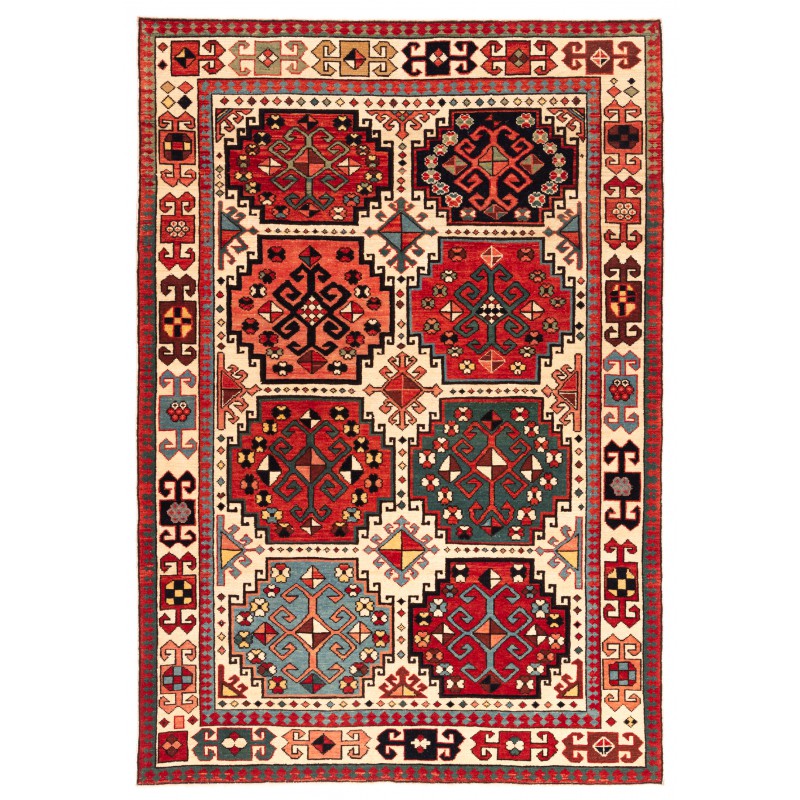
- Stock: 売り切れ
- Model: C31011
- サイズ: 118cm x 169cm
- SKU: ART8
- Location: yildirim
この絨毯の情報源は、Ian Bennett&Aziz Bassoulによる「Tapis du Caucase – Rugs of the Caucasus」(ニコラス・スルスク美術館、レバノン・ベイルート、2003年)の第24号や、Ian Bennettによる「Oriental Rugs Volume 1 Caucasian」(オリエンタル・テキスタイル・プレス、アバディーン、1993年)の第68号、およびE. Gans-Reudinによる「Caucasian Carpets」(テムズ&ハドソン、スイス、1986年)の118ページです。この絨毯は、コーカサス地域のカザク地域で19世紀後半に作られた、「メムリング(メムリンク)・グル」と呼ばれるフック模様の多角形と十字のデザインで有名であり、どこでも見られるものです。カザク、カラバフ、ゲンジェ、モガン地区で織られた絨毯を区別するのはしばしば困難です。「メムリング・グル」と呼ばれる八角形内に段々とフックされた長方形が連なるデザイン(15世紀のフランドルの画家ハンス・メムリングにちなんで名づけられたもので、彼の絵画の一部にはこのような絨毯が描かれています)は、しばしばモガン地区に帰属されていますが、明確な証拠がないままです。このデザインの絨毯はコーカサスの他の地域でも織られ、メムリングの絵画や15世紀から16世紀の他のフランドルやイタリアの画家の作品に登場する絨毯は、おそらくカフカス地域ではなくトルコ産であったと一般的に考えられています。しかしこの理論は未だに証明されていません。この絨毯は「メムリング・グル」を中央にしたメダリオンデザインです。八角形に囲まれたひし形の中には、十字形に配置された大きなカーブフックが描かれています。これはモガン地区の絨毯に特徴的なデザインです。この絨毯のデザインは解釈され、元の絨毯に合う最適な色が使用されています。
The source of the rug comes from the book Tapis du Caucase – Rugs of the Caucasus, Ian Bennett & Aziz Bassoul, The Nicholas Sursock Museum, Beirut, Lebanon 2003, nr.24 and Oriental Rugs Volume 1 Caucasian, Ian Bennett, Oriental Textile Press, Aberdeen 1993, nr.68 and Caucasian Carpets, E. Gans-Reudin, Thames and Hudson, Switzerland 1986, pg.118. This is a famous, and ubiquitous, design of hooked polygons with crosses (called ‘Memling ( Memlinc ) gül‘) from the late 19th century, Kazak region, Caucasus area. It is often difficult to distinguish between rugs woven in the Kazak, Karabakh, Genje, and Moghan districts. Rugs with rows of stepped and hooked rectangles within octagons (the so-called “Memling gül” named after the 15th-century Flemish artist Hans Memling, in some of whose paintings such rugs are depicted) are often attributed without clear evidence to Moghan. As well as in many other Caucasian areas, pieces of this design were also woven in Anatolia, and it is generally assumed that the rugs which appear in Memling’s paintings, and those in the works of another 15th and 16th century Flemish and Italian painters, were probably Turkish rather than Caucasian. This theory, however, remains unproven. This is a medallion design with “Memling güls“. The “güls“, consisting of eight-stepped hooked octagons enclosing a rhombus bearing of large curved hooks in a cruciform arrangement, are a design typically found in rugs of the Moghan district. The design of this rug is interpreted and the most appropriate colors to match the original are used for this rug.
